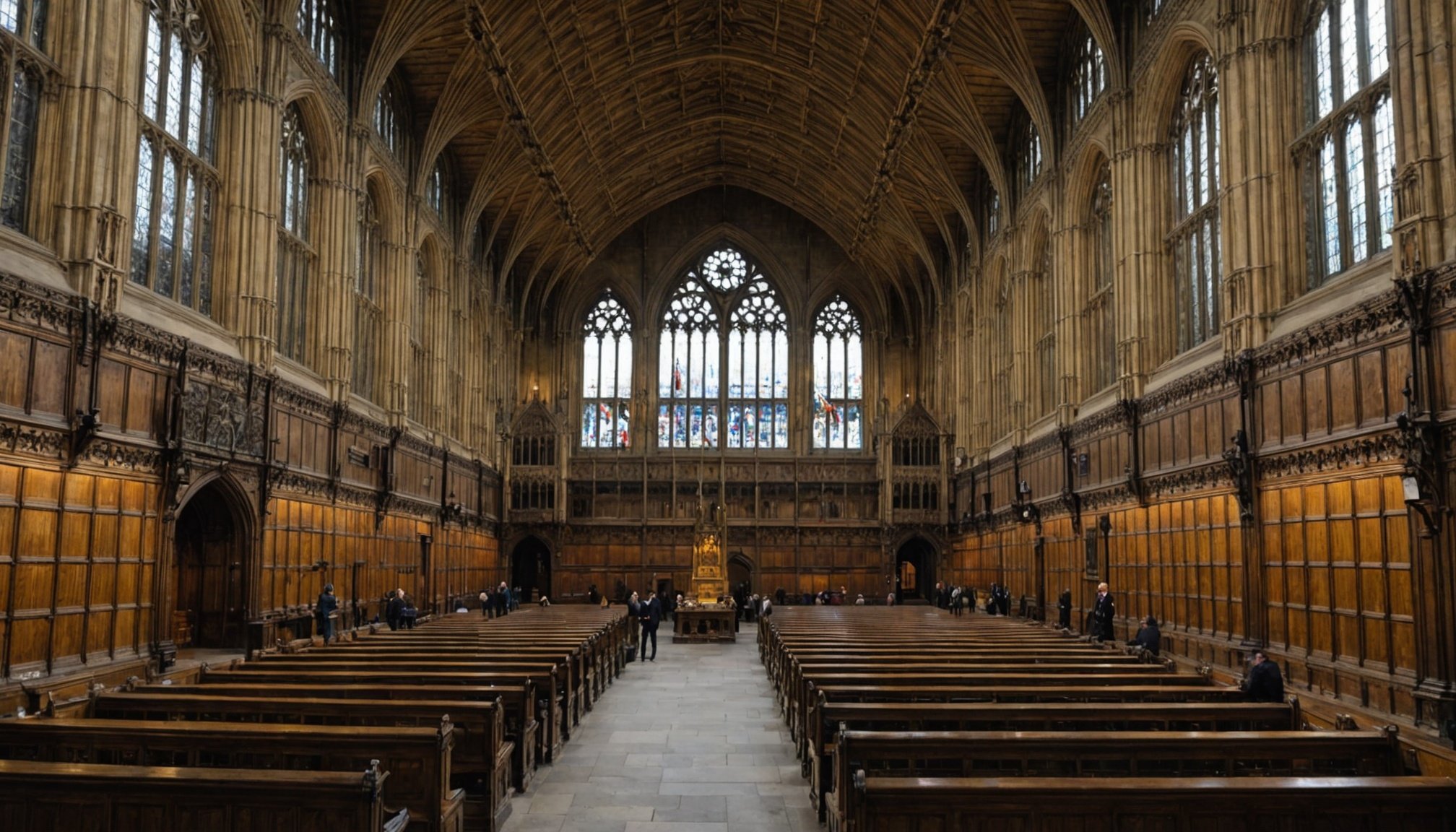Overview of the Houses of Parliament
The Houses of Parliament stand as a central foundation in British governance and have played a pivotal role throughout history. Serving as the hub for the United Kingdom’s political discourse, these buildings house both the House of Commons and the House of Lords. Their historical significance spans centuries, hosting debates and decisions that have shaped not just the UK but also global affairs.
Architecturally, the Houses of Parliament, primarily designed by Sir Charles Barry and Augustus Pugin, are a remarkable blend of Gothic Revival and classical styles. Key features include the iconic Big Ben (now known as the Elizabeth Tower) and the elaborate facades that showcase intricate detailing and craftsmanship. Notable for their cultural and national symbolism, these structures reflect the transition and modernisation within British politics.
This might interest you : Explore chester”s rich roman legacy: a journey through historical landmarks with ancient origins
Culturally, the Parliament continues to be a pivotal location for political gatherings and discussions that impact contemporary policymaking. Hosting millions of visitors each year, it offers insights into the UK’s rich political heritage while seamlessly integrating historical elements into today’s political processes. For those looking to explore these architectural wonders, the Houses of Parliament symbolize both heritage and modern governance.
Booking a Private Tour
Navigating the booking process for a private tour of the Houses of Parliament can be straightforward with the right guidance. Follow these steps to ensure a seamless experience.
Topic to read : Craft cherished moments: the ultimate guide to planning a romantic private boat cruise on the thames
-
Visit the Official Website: Begin by accessing the official Houses of Parliament website. It offers comprehensive information on available sessions and dates, enabling you to select a convenient time.
-
Complete Necessary Registration: You’ll need to fill out an online form with details such as the number of attendees and your preferred date. Ensure that all information is accurate to avoid any scheduling conflicts.
-
Provide Required Documentation: Visitors must present valid identification, usually a passport or national ID, during both the booking and actual tour. This policy ensures security and access compliance.
-
Plan Your Visit: Early booking is recommended, particularly during peak tourist seasons. This strategy increases the likelihood of securing your desired time slot.
-
Receive Confirmation: Once your booking is finalized, you’ll receive a confirmation email. It is essential to keep this document handy, as it will be required on the day of your tour.
Leveraging these private tour steps streamlines preparation, ensuring an enriching and hassle-free visit.
Insider Tips for Your Visit
Enhancing your visit to the Houses of Parliament can transform an ordinary tour into an extraordinary experience. Insider tips from seasoned visitors can unlock a different perspective of these historical halls. Engaging in guided tours is recommended, as they offer expert insights and little-known facts about the building’s history and architecture.
To capture your unique journey, consider exploring lesser-known areas. Seek permission to photograph iconic yet understated spots like Westminster Hall. It’s a treasure trove of history, often overshadowed by more popular sites. Photography enthusiasts should aim for early morning tours to take advantage of the natural light filtering through the stained glass windows.
Interacting with knowledgeable tour guides enriches your visit. Prepare questions in advance to maximize your engagement. Curious about the architectural influences? While guides provide historical context, they’re also your best bet for discovering quirky anecdotes about past debates and renovations.
Remember, planning enhances your visitor experience. Allow ample time to navigate security and queues; arriving early is always advantageous. These practical steps ensure a rewarding and memorable exploration of one of Britain’s most iconic political landmarks.
Visitor Testimonials and Experiences
Learning from past visitors can enhance your experience at the Houses of Parliament. Visitor feedback often highlights the awe-inspiring architecture and the passionate narratives provided by tour guides. One consistent theme in personal experiences is the profound understanding gained of British governance’s evolution. Many share a newfound appreciation for the historical significance embedded in the walls of this iconic institution.
Past visitors frequently mention the meticulous security processes, advising future guests to be patient and prepared. Gathering tips from others, like arriving early and engaging actively with guides, can significantly elevate your visit.
Insights also include recommendations to explore lesser-known areas like private chambers, where important historical decisions have been made. Such experiences are cited as unforgettable, offering a deeper connection to the building’s past and present.
The heartfelt testimonials paint a vivid picture of what to expect during a private tour—from the richly detailed architectural features to the vibrant political history brought to life by exceptional guides. These shared stories not only prepare you but also ignite anticipation for a memorable dive into British political heritage.
Frequently Asked Questions
To ensure a smooth experience at the Houses of Parliament, we’ve compiled answers to some frequently asked questions from visitors.
What should I know before booking a private tour?
Precision: Booking a private tour requires visiting the official Houses of Parliament website, completing a registration form, and presenting valid identification, such as a passport. Early booking is advised to secure your preferred tour slot.
Are tours accessible to everyone?
Precision: Yes, the Parliament offers wheelchair access and hearing assistance upon request. It’s recommended to inform the staff of any special requirements when booking your tour.
What facilities are available to visitors?
Precision: Facilities include a visitor café and gift shop, where souvenirs reflecting the architectural and historical significance of Parliament can be purchased. Cloakrooms are available for storing personal items.
When planning, consider these tips based on frequent queries:
- Arrive early to allow time for security procedures.
- Engage actively with tour guides to enrich your experience.
- Check for any scheduled closures due to parliamentary sessions to avoid disruptions.
Arming yourself with this information ensures a well-prepared and engaging visit to this prominent symbol of British governance.
Relevant Contacts and Resources
To facilitate your visit to the Houses of Parliament, having access to essential contact information and resources is invaluable. Begin by exploring the official resources available on the Houses of Parliament website, which offers comprehensive details on bookings, accessibility, and event schedules.
For specific inquiries, a designated customer service team can be reached through the contact details provided on the website. It’s beneficial to note these for any immediate questions or assistance during your private tour. When booking, ensure you have all relevant contact numbers handy to resolve any potential issues swiftly.
Utilise online resources like virtual tours and historical archives to enhance your understanding and appreciation ahead of your visit. These tools can provide deeper insights into the architectural and historical aspects of Parliament.
Tour guides play a critical role in bringing the stories of Parliament to life. When selecting a guide, consider recommendations from past visitors and reviews posted on travel forums. Engaging with experienced guides can significantly enrich your tour, offering unique perspectives and lesser-known facts that elevate the overall experience.
Brief History of the Houses of Parliament
Exploring the history of Parliament offers insight into its pivotal role in British governance. The journey begins in the early medieval period, with its establishment as a central legislative body. The significant events that have unfolded within its halls have affected both national and international spheres.
Throughout centuries, Parliament has witnessed multiple remodels, notably after the 1834 fire that devastated large sections. This led to the creation of its iconic architectural features by Sir Charles Barry and Augustus Pugin in the Gothic Revival style. Their work has contributed significantly to the building’s evolution, preserving its grandeur through continuous restoration efforts.
Numerous notable figures have left their mark on Parliament’s history, including pivotal figures like Winston Churchill, who inspired reforms and shaped the country’s direction during challenging times. Their contributions echo through the halls, enriching the legislative fabric of Britain.
The evolution of the Houses of Parliament reflects not only architectural advancements but also its enduring historical significance. The building stands as a testament to the resilience and adaptability of British politics, continuing to serve as a symbol of democratic governance worldwide.



